Where there are so many people in this world, the occurrence of conflict is inevitable. This article is about conflict and stages of the conflict.
With the increasing population, there is a vast pool of opinions. This births conflict.
When there is no way to avoid conflict, then what should we do? We should learn to resolve the conflicts.
How to resolve the conflicts? The only way that exists so far is to recognize the conflict first.
How we can recognize the conflict? By understanding the stages of the conflict.
5 Stages Of Conflict – A Detailed Review Of Conflict Cycle:
There are five stages of conflict. We can resolve these by understanding and learning how to solve the issue.
We should not proceed to the article without defining the main point. So for a better understanding let’s define the conflict first.
What is the conflict? Conflict is a clash of interest among different people or groups.
It’s a condition of disagreement and argument about something important.
Organizational conflict occurs when the goals and of different groups are incompatible.
And those individuals or groups hinder the attempts of others to achieve their goals.
We will identify the stages that how conflict is born and grows in an organization. In this article, we will look at the stages of a conflict covering the birth, rise, and ending in it.
There are five phases resulting in conflict. These define how conflict takes place in organizations.
Let’s take a deep look at each of these stages to have a better understanding of the conflict.
1. Latent Conflict Is First In Stages Of Conflict:
In this phase of the conflict, people are indulged in conflict without being conscious of the conflict.
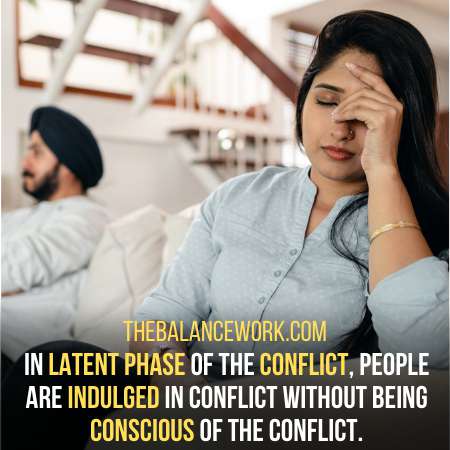
It’s a stage where there is an existence of some particular factors. These factors are capable to become forces that can cause conflict in the future.
For instance, a waiter of the hotel may noted a wrong order. And the food doesn’t complies to the order noted.
The supervisor and the consumer are not aware of the situation. And the conflict hasn’t birthed still.
The latent conflict has further four types and these are:
-Competitiveness for scant means: It means that there exists a scarcity of resources. And the consumers for these resources are large in number.
For example, there is an advertisement for only one job position. But more than one person is applying for this job.
-An urge for independence: Autonomy is the desire to be self-directed. When everyone would try to follow their own directions.
There would be no one to follow the authority. This births conflict.
For example, a manager is micro-managing the employees and they need freedom.
-The divided goals: This is a situation in which there is a conflict between the goals of two or more people.
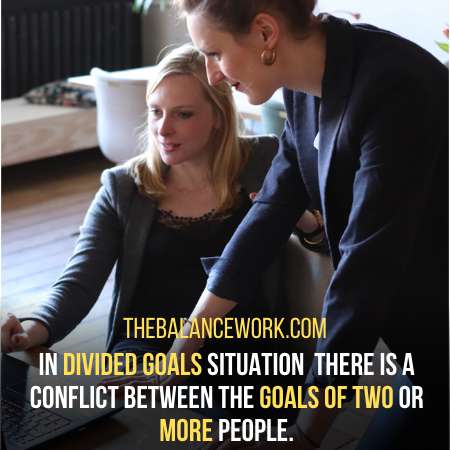
These people otherwise should be working together to achieve mutual benefits.
An employee and his colleague had the same task to do together. But they cannot reach a decision together.
-Role conflict: It happens when there are incompatible demands from a person. And these demands are the ones related to their position.
E.g. a manager finds himself in role conflict when he gets pulled from various directions. And he tries to respond all at once to many statuses he holds.
2. Perceived Conflict Is The Second Stage Of Conflict:
Conflict can exist even when there is no condition of conflict at the previous stage.
This is the part of conflict where one person might perceive that the other one is creating hurdles. And these hurdles are affecting their own goals.
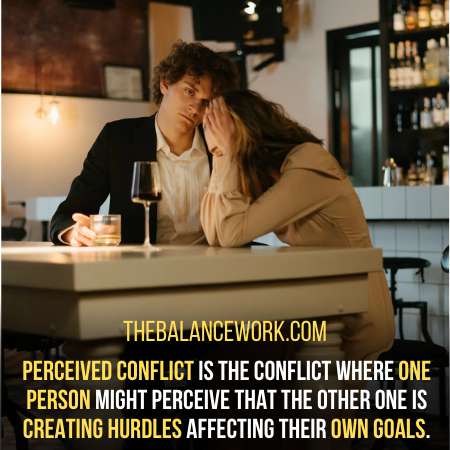
At this stage, people become aware that a conflict does exist.
Second, when people perceive that a conflict arises without the latent conflict.
This condition might occur due to the people having a misconception. The misconception can be about the positions they hold.
For example, there might be a situation where two parties perceive conflict to exist.
But after a dialogue, they realize that indeed there was no difference in their opinions. So there was no conflict from the very start.
In this case, the stages of conflict do not proceed to the next. This issue of perception can get resolved by proper communication.
Yet, the right amount of communication is also necessary. Too much communication, too little communication, can lay the basis for conflict.
But, there is no perception of conflict nor felt when it actually exists. To feel the conflict, it’s necessary to perceive it first.
See Also: 7 Barriers To Effective Listening (Guaranteed Solution)
3. Felt Conflict Is Third In Stages Of Conflict:
That’s the part of the conflict where people can feel the conflict instead of just realizing or perceiving it.
So this stage is also known as personalization of conflict.
Here the conflict perceived before ends up having an impact on the person.
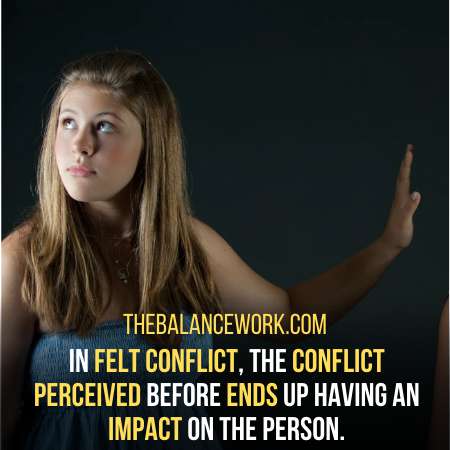
For instance, a person knows that he had an argument with someone else over a strategy. Yet, this doesn’t make the first person lose his affection towards the second one.
The externalization of conflict causes some serious concerns. These concerns are somewhat related to the disturbances in conflict. Or you can say that it causes them to sense the clash.
What do you think why the personalization of conflict happens? There may be two reasons for this.
Causes for externalization of conflict
–There arises an inconsistent demand within the individual. This demand links to the need for efficient organization and advancement of an employee.
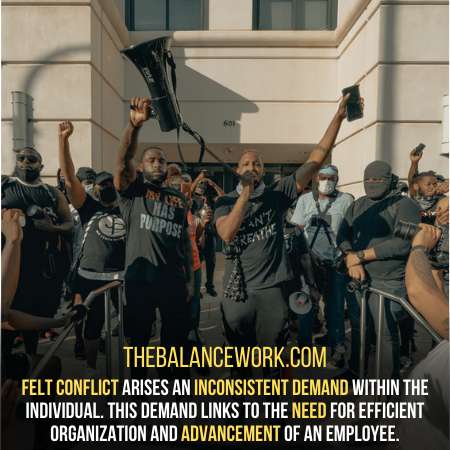
The result of this is the emergence of anxiety. The individual may feel anxious due to crisis or extra-organizational pressures.
To get out of such situations, the individual should blurt out his concerns. So that he can maintain his internal equilibrium.
–The second reason for this is the involvement of the individual. Externalization of conflict happens when the individual’s character indulges in the connection.
The aggressive notions are usual in close relations. And this happens in institutions or colleges where people are aggressive.
On the other side, there won’t be any personalization of conflict. This happens when someone is able to not take a situation too personally.
So in this case, even after latent and perceived conflict exists. The conflict would not progress to the “Felt conflict” stage.
You may have felt this in your personal life that even if there is a conflict between you and someone. But you don’t give it much attention and the conflict fades away.
4. Manifest Conflict Is Fourth Stage Of Conflict:
That’s the part of conflict where two different people show certain behaviors. These certain behaviors urge one another for reactions or comebacks.
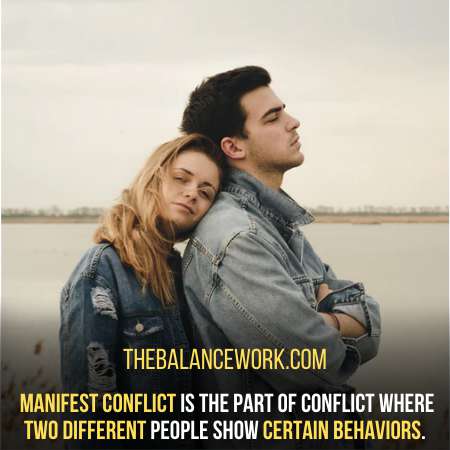
These behaviors may be as overt as physical or verbal violence.
The most frequent responses are aggression, apathy, and sabotage. Which sometimes gets followed by a withdrawal or compliance to regulations.
It’s quite infrequent to have ferocity in the result of the manifest conflict. It happens only during prison riots, political revolutions, or labor conflicts.
To know about the manifestation of conflict, it is important to look at the context of conflict.
But conflict may not get manifested. If one party is unaware that their behavior is frustrating to the other person.
At this point, communication with someone can help to bring the conflict to the surface.
And a mediator or arbitrator can help by addressing the conflict. He can deal with the person who was unaware of the impact of his behavior.
It can be useful to try a “perception check”. This is to verify whether the perception of another person’s behavior was actual. Or it was mere perception.
5. Conflict Aftermath Is Last In Stages Of Conflict:
After seeing the way in which the conflict was set on. The aftermath of conflict can be positive or negative.
In case the clash got resolved in a genuine way. And all the participants are happy. This can help to create a cohesive and coordinated surrounding.
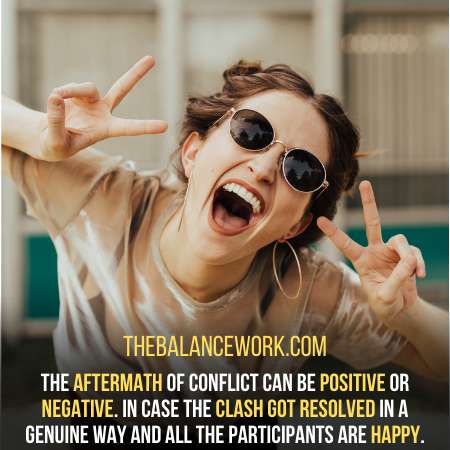
Or the individuals can focus on the latent conflicts. The conflicts which were not resolved in the past. They will do so to have a strong relationship.
But, if there is no proper resolution to the conflicts. And the conflicts get suppressed without any rectification.
Then this might result in the aggravation of latent circumstances of the clash. And this would lead to an explosion in even a severe situation.
This episode of conflict is “Conflict Aftermath”. So this is a reminder that addressing conflicts in a constructive way is important.
This can lay the groundwork for a healthy and happy relationship in the future. And this would prove to be the closure for stages of the conflict.
Conclusion
Summarizing this article, we can say that stages of conflict let us look at the conflict in a different way. Conflict is not only the behavior that relates to our perceptions of conflict.
Conflict is all about the situation, context, and conditions leading to conflict.
Then there is a need to perceive the conflict. Depending upon whether we get affected by it or not, then we should feel it.
In the end, when we are aware that we are impacting the other person but we continue to do so. Then the conflict comes into manifestation.
The advantage we can take is by the choice of how we prevent the conflict. And when we prevent it i.e. before, during, or after the conflict.
There are different stages at which we can intervene in a situation. And we can change the fate of conflict.
We can change our reactions in a situation. This would cause an impact that whether a conflict goes bad or good.
Drop a comment to share your thoughts on conflict and its stages.
Last Updated on 13 hours by Shahzaib Arshad
- 7 Jobs For People With Cerebral Palsy – Tips To Manage Yourself - October 6, 2022
- 15 Easy-On-Hand Jobs For People With Chronic Fatigue In 2022 - October 2, 2022
- 9 Effortless Jobs For People With Agoraphobia - October 1, 2022